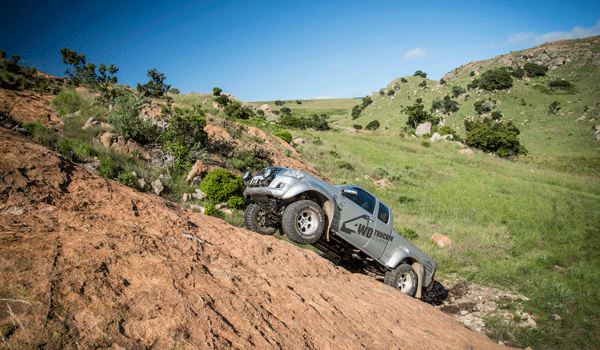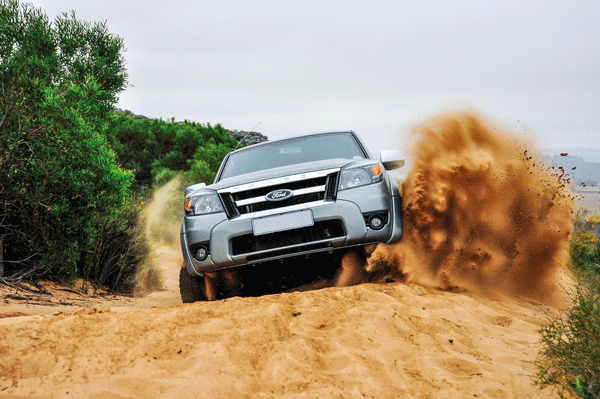Our 4×4s are ever more sophisticated and packed with off-road driving aids. But, as Grant Spolander points out, a few fundamental tricks will still go a long way to keeping you from digging in the dirt
I once took part in a 44 challenge in Port Elizabeth. Most of the vehicles were highly modified, but one driver arrived in a bog-standard Toyota Fortuner. His name was Gerhard Groenewald. It was his first official off-road challenge; but, as a seasoned overland traveller and owner of Klipbokkop (a highly respected 4×4 academy in Worcester), he was no stranger to off-road driving.
On that day, I watched in jaw-dropping awe as Gerhard sailed his off-the-shelf Fortuner through vehicle-busting obstacles. He never once faltered, reversed for a second try or buried the throttle in a desperate attempt to plough through the course. It was like watching a master composer directing his wheels to the high-low notes of the terrain.
I watched Gerhard’s every move with a ‘stealy’ eye, hoping I could mimic his results, but I wasn’t having much luck. Not until the sixth obstacle, when his tactic finally became clear: the answer lay in momentum.
It’s a well-known fact that momentum is a key tool for tackling off-road terrain. Ironically, I had learnt this lesson many years before at the Klipbokkop academy, but the concept only became clear once I’d witnessed its application firsthand.
There’s a common tendency to confuse momentum with speed, but the trick (as Gerhard proved that day) is to simply maintain a fixed speed. Changing your speed once you are in the obstacle often leads to a loss of momentum. And, to be clear, this does not only apply to backing off the throttle; it also includes throttle increases – which is where most folks go wrong.
When you are driving through an obstacle off-road, there can be a strong urge to increase speed the instant you detect a loss of momentum. It’s a totally instinctive reaction – the vehicle slows down, and so the natural response is to accelerate.
Unfortunately, most ditches, dips and obstacles are created by other drivers who have previously spun their wheels in exactly the same location. And, the chances are, the same will happen to you as you increase your wheel speed; that’s when the tyres break traction and momentum is lost.
There are many more tips and tricks for driving off-road. But, by far the most important factor is momentum, which works hand in hand with getting the correct approach speed. If you don’t get that speed right the first time, don’t be afraid to reverse your vehicle and give it another go, but a fraction faster.
This brings us to the second most important 4×4 trick: reading the terrain.
Travelling off-road on holiday is far riskier than taking part in an organised 4×4 challenge. This may sound like an absurd statement, but most competitions have a recovery vehicle on standby and no shortage of participants eager to help out if you get stuck.
In contrast, a trip through Namibia’s isolated north-west region (for example) requires the utmost respect and care for your vehicle and its surroundings. Every obstacle you encounter should be treated as a threat to both your personal safety and your car. A breakdown in Namibia’s hinterland could see you stranded for weeks before you chance upon another vehicle willing to help.
For this reason, it’s absolutely crucial to read the terrain before approaching an obstacle. This means taking the time to get out of the car and assess the road (Is it loose, rocky, sandy or slippery?), minimising your risks by picking the path of least resistance and sticking to your chosen line.
What’s more, it’s at this point – prior to entering the obstacle – that you should engage your vehicle’s driving aids. Never wait until it’s crucially needed to turn on the diff lock or traction control. These off-road driving aids work far better as preventive tools than recovery ones.
The same applies to a set of recovery tracks – use them before you need them. Generally speaking, recovery tracks are designed to aid traction when you have your wheels bogged down. However, if you suspect the terrain is loose or soft, or if there’s a steep ridge to climb, don’t wait to find out how your car will fare – place your recovery tracks where they are needed most. In short, you want to minimise your risks and the potential limitations of your vehicle.
Finally, as with most activities, practice makes perfect. The more time you spend off-road, the better equipped you’ll be for choosing the right line, judging the best speed and, ultimately, maintaining uninterrupted momentum.
And this – regardless of what 4×4 you own – should prove more than adequate for the exploration of Southern Africa’s boundless back roads and the building of lifelong memories.
OFF-ROAD TIPS
• Exit your vehicle and read the terrain if you’re unsure of an obstacle.
• Choose the path of least resistance.
• Drive as slowly as possible and as fast as necessary.
• Maintain momentum. Resist the urge to make sudden throttle inputs.
• Engage 4WD on gravel roads. It’s safer and you’ll have more traction.
• Never attempt an obstacle in 2WD. You are likely to damage your vehicle, get stuck and harm the environment.
• Engage your vehicle’s off-road driving aids prior to entering an obstacle. Don’t wait for things to go wrong.
• If you have a set of recovery tracks, lay them down before entering an obstacle.
• When entering a river or other water crossing, be absolutely sure of the depth before driving on, even if it means you have to get out and walk through the water first.
• Always deflate your tyres when driving off-road.
Photography Grant Spolander
(This article was first published in the autumn 2015 issue of AA traveller magazine)





